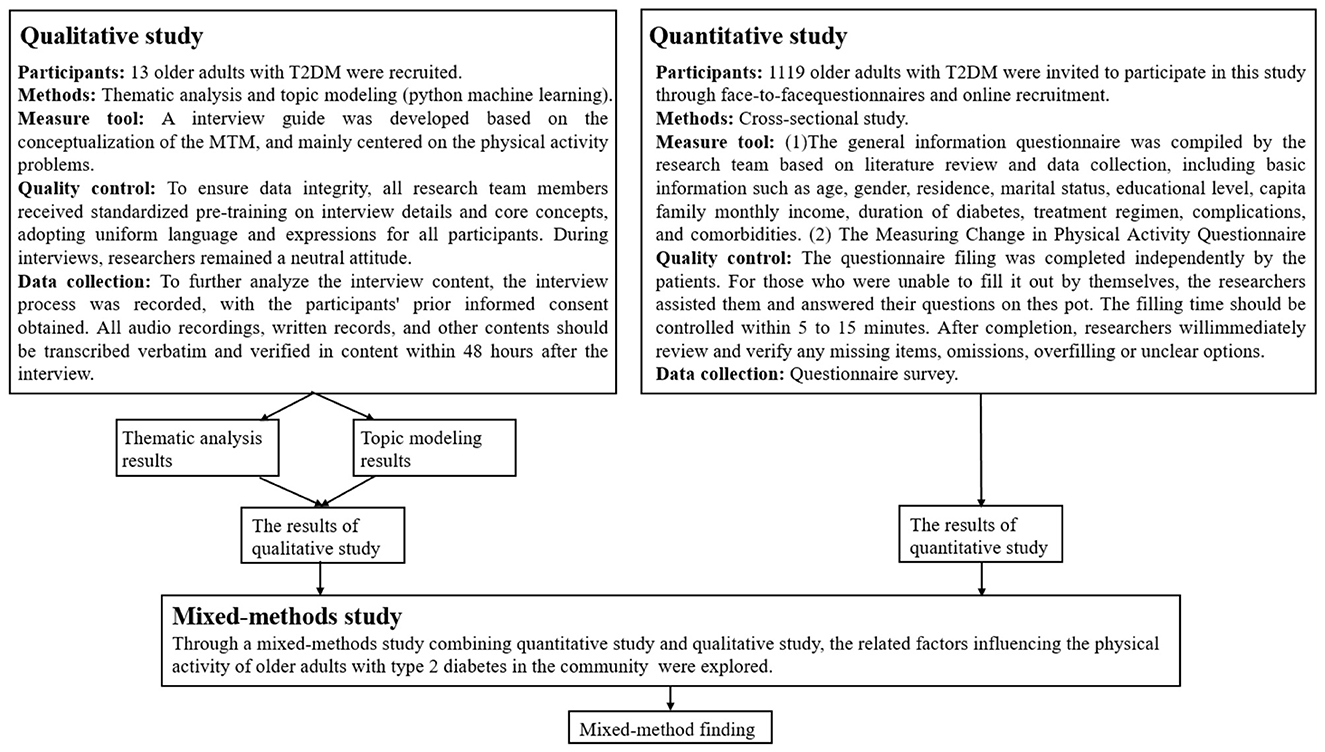- 1School of Nursing, Shanxi Medical University, Taiyuan, China
- 2Balingqiao Community Health Service Center of Xinghualing District, Taiyuan, China
- 3Shanxi Bethune Hospital, Shanxi Academy of Medical Sciences, The Third Hospital of Shanxi Medical University, Tongji Shanxi Hospital, Taiyuan, China
- 4The First Clinical Medical College of Shanxi Medical University, Taiyuan, China
- 5The Second Clinical Medical College of Shanxi Medical University, Taiyuan, China
by Huai, P., Zhang, B., Sun, J., Xu, R., Zhang, L., Qiao, X., Sun, W., Yang, H., Guo, J., and Su, H. (2025). Front. Public Health. 13:1634294. doi: 10.3389/fpubh.2025.1634294
There was a mistake in Figure 1 as published. In the measure tool of the Quantitative study, the “(2) the Measuring Change in Physical Activity Questionnaire” was not included. The corrected Figure 1 appears below.
Figure 1. Design of the study using a mixed method of quantitative study and qualitative study.
We found that in 2.3.2 Measures, there is a lack of an introduction to “Measuring Change in Physical Activity Questionnaire.”
A correction has been made to the section 2.3.2 Measures as follows:
2.3.2.2 Measuring change in physical activity questionnaire
Intentions to engage in physical activity were evaluated using the Measuring Change in Physical Activity Questionnaire (MCPAQ). It was originally developed in English based on the MTM construct by Sharma (62). The higher the scores of changes in physical activity, the greater the likelihood of conducting physical activity behavior change. Yang et al. (63) obtained authorization from the original authors of the MCPAQ and conducted a cross-cultural adaptation to develop a Chinese version of the scale. This version was validated in hypertensive patients and demonstrated good reliability and validity: Cronbach's alpha was 0.911 for the overall scale. The scale is considered broadly applicable across diverse populations.
The original version of this article has been updated.
Generative AI Statement
Any alternative text (alt text) provided alongside figures in this article has been generated by Frontiers with the support of artificial intelligence and reasonable efforts have been made to ensure accuracy, including review by the authors wherever possible. If you identify any issues, please contact us.
Publisher's note
All claims expressed in this article are solely those of the authors and do not necessarily represent those of their affiliated organizations, or those of the publisher, the editors and the reviewers. Any product that may be evaluated in this article, or claim that may be made by its manufacturer, is not guaranteed or endorsed by the publisher.
References
62. Sharma M. Theoretical Foundations of Health Education and Health Promotion. Burlington, MA: Jones & Bartlett Learning (2022).
Keywords: multi-theory model, type 2 diabetes, older adult, community, factors, mixed-method study
Citation: Huai P, Zhang B, Sun J, Xu R, Zhang L, Qiao X, Sun W, Yang H, Guo J and Su H (2025) Correction: From the perspective of multi-theory model, factors influencing physical activity among community-dwelling older adults with type 2 diabetes in China: a mixed-methods study. Front. Public Health 13:1713194. doi: 10.3389/fpubh.2025.1713194
Received: 25 September 2025; Accepted: 30 September 2025;
Published: 23 October 2025.
Edited and reviewed by: Fernanda M. Silva, University of Coimbra, Portugal
Copyright © 2025 Huai, Zhang, Sun, Xu, Zhang, Qiao, Sun, Yang, Guo and Su. This is an open-access article distributed under the terms of the Creative Commons Attribution License (CC BY). The use, distribution or reproduction in other forums is permitted, provided the original author(s) and the copyright owner(s) are credited and that the original publication in this journal is cited, in accordance with accepted academic practice. No use, distribution or reproduction is permitted which does not comply with these terms.
*Correspondence: Huancheng Su, MTA5MDY0NDk1MEBxcS5jb20=; Jinli Guo, Z2psZ2JkQDEyNi5jb20=
‡ORCID: Panpan Huai orcid.org/0009-0002-2782-001X
Bo Zhang orcid.org/0009-0004-6930-6128
Linghui Zhang orcid.org/0009-0006-7485-0026
Hui Yang orcid.org/0009-0009-8466-9126
Jinli Guo orcid.org/0009-0004-9654-5888
Huancheng Su orcid.org/0009-0002-5215-5787
†These authors have contributed equally to this work and share first authorship
 Panpan Huai1†‡
Panpan Huai1†‡ Bo Zhang
Bo Zhang Jingjing Sun
Jingjing Sun Linghui Zhang
Linghui Zhang Hui Yang
Hui Yang Huancheng Su
Huancheng Su